In the sprawling solar farms of California and the rooftop arrays dotting suburban neighborhoods, a quiet revolution is brewing—one that most consumers never see. While the solar industry has spent decades perfecting the art of capturing sunlight, it's now facing its most critical challenge: what happens when those gleaming panels reach the end of their 25-30 year lifespan.
The numbers are staggering. By 2030, the International Renewable Energy Agency projects that solar panel waste will reach 8 million metric tons annually. By 2050, that figure could balloon to 80 million metric tons—enough to fill over 4,000 Olympic-sized swimming pools each year. Yet behind these alarming statistics lies an emerging industry that's turning potential environmental disaster into economic opportunity.
Several startups have emerged as pioneers in this space, developing innovative methods to recover valuable materials from retired panels. Companies like ROSI Solar in France and First Solar in the United States have developed proprietary processes that can recover up to 95% of a panel's materials, including silver, copper, silicon, and glass. The economics are compelling: a single ton of solar panels can contain silver worth approximately $6,400 at current market prices, along with recoverable aluminum, copper, and high-purity silicon.
The recycling process itself reads like something from a science fiction novel. Panels are first disassembled manually to remove aluminum frames and junction boxes. They then undergo thermal processing at around 500°C to burn off plastic components and break the bond between cells and glass. The remaining materials are separated using various techniques including mechanical shredding, electrostatic separation, and chemical processes to isolate precious metals.
What makes this emerging industry particularly fascinating is how it's creating circular economy opportunities that didn't exist just five years ago. Recovered silicon can be purified and reused in new panels, glass becomes construction material or new panel components, and metals re-enter manufacturing streams. This closed-loop approach reduces the need for virgin materials mining, which itself carries significant environmental costs.
The regulatory landscape is rapidly evolving to support this transition. The European Union's Waste Electrical and Electronic Equipment (WEEE) Directive already requires solar panel manufacturers to finance the collection and recycling of their products. In the United States, Washington state has implemented its own solar stewardship program, with several other states considering similar legislation. These policies are creating the economic frameworks that make recycling financially viable rather than environmentally optional.
Consumer awareness remains one of the biggest challenges. Most solar panel owners simply don't know that their systems will eventually need responsible disposal, or that recycling options even exist. Educational initiatives from companies like EnergySage and SolarPower World are beginning to address this knowledge gap, but much work remains to be done.
The technological innovation happening in this space is equally remarkable. Researchers at the National Renewable Energy Laboratory are developing non-destructive methods to repair and refurbish panels rather than recycling them, potentially extending their useful life by another decade. Other companies are exploring ways to repurpose retired panels for less demanding applications where maximum efficiency isn't critical, such as powering agricultural sensors or emergency lighting systems.
Financial models for solar recycling are also evolving. Some companies offer buy-back programs for old panels, while others are developing lease structures that include end-of-life recycling costs upfront. These approaches help address the current reality that recycling costs—typically $15-45 per panel—still exceed the value of recovered materials in many cases.
The international dimension adds another layer of complexity. China, which manufactures the majority of the world's solar panels, is also developing its recycling infrastructure. Meanwhile, developing nations that have imported large quantities of solar equipment now face the challenge of managing future waste streams without established recycling facilities.
What's clear is that the solar industry's next chapter won't be written in manufacturing facilities or installation sites, but in recycling plants and research laboratories. The companies that solve the end-of-life challenge will not only ensure the sustainability of solar energy but position themselves for enormous economic opportunity. As one industry insider told me, 'We're not just cleaning up the past—we're building the foundation for the next century of solar energy.'
The revolution won't be televised, but it might just be recycled.
The hidden revolution: how solar panel recycling is quietly reshaping the energy industry

